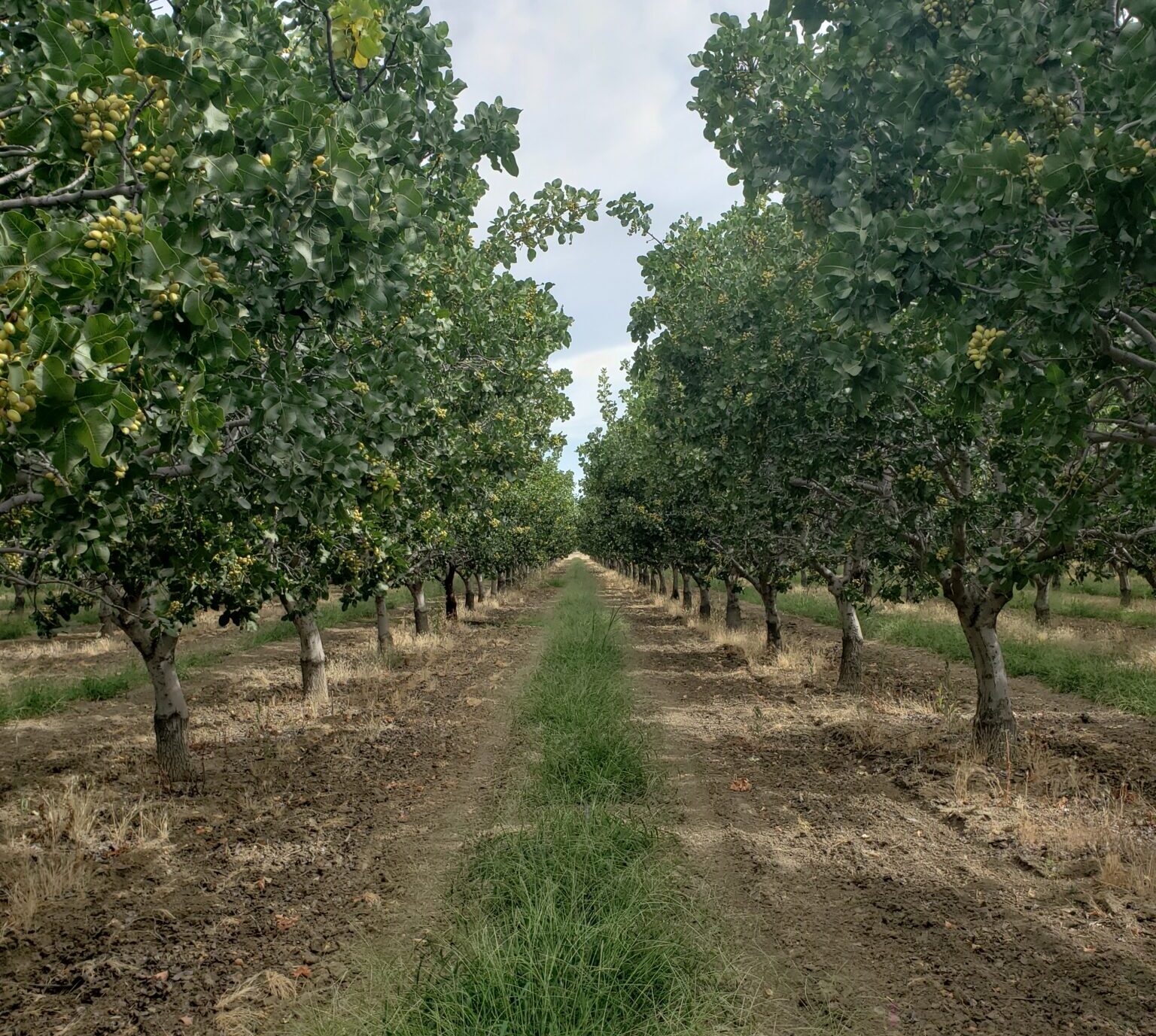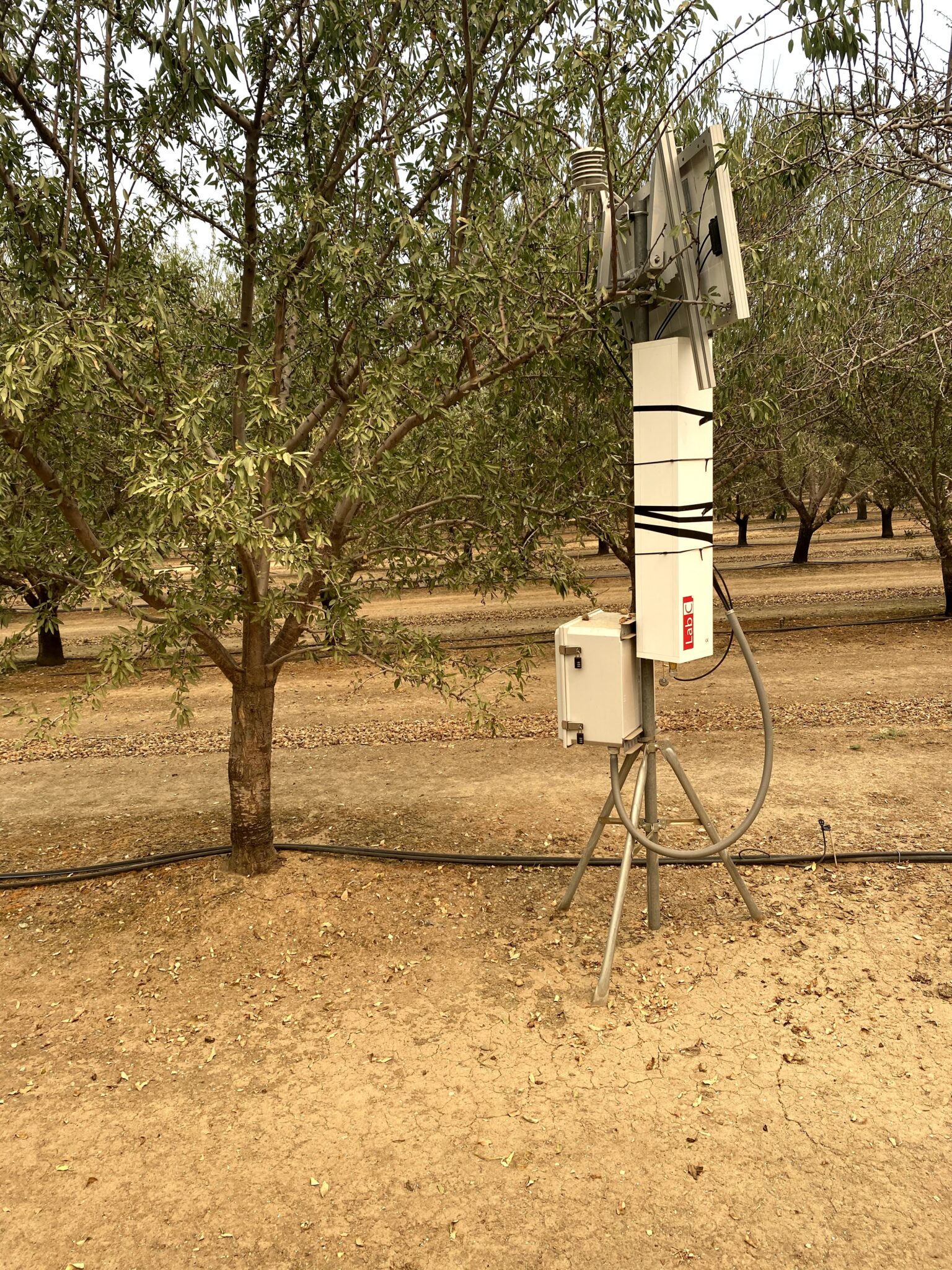
Low precipitation over the last year in the San Joaquin and Sacramento Valleys and long-term drought are forcing pistachio growers to make tough decisions for their irrigation management.
While pistachios are known for their ability to withstand drought, enough water stress can still cause high percentages of blanks, low shell splitting percentages and reductions in overall yield.
To mitigate these issues, UC experts recommend pistachio growers employ water budgeting strategies, monitor tree water stress levels and implement drought management techniques, such as proportional decreases in water application throughout the season or regulated deficit irrigation at different stages in crop development.
Water Budgeting
Water budgeting, along with soil moisture monitoring, helps to keep track of water depletion and eventually minimize water stress damage to tree health, growth and nut quality during normal years and drought. Daniele Zaccaria, UCCE agricultural water management specialist, said in a June 2021 UCCE In a Nutshell newsletter article co-authored by UCCE Farm Advisor Mae Culumber that a water budget considers the amount of irrigation needed to replace water losses from transpiration by trees and vegetative cover and evaporation from the soil surface, known in combination as crop evapotranspiration (ETc).
Irrigation is needed when the actual ETc exceeds water inputs and soil moisture storage. “They [growers] try to refill the soil profile every now and then, and then they keep showering a little bit of water to keep the soil moisture in the root zone pretty optimal. This is in a normal year,” said Zaccaria in an interview. “This year is not normal. They try to supply an adequate amount of water in the most sensitive stages and then reduce the applications in stages that are less or not sensitive to water stress.”
Under constrained water supplies during drought years such as this one, growers need to be strategic with their on-farm water allocation, and it has been shown that regulated deficit irrigation can result in improved water use efficiency without significant reduction in nut yields, according to Isaya Kisekka, associate professor of agro-hydrology and irrigation at UC Davis.
In pistachio, multiple UC studies have found that regulated deficit irrigation is effective in saving water without stressing the tree enough to adversely affect yields at harvest. “[In pistachio], there are sensitive and less sensitive stages,” Zaccaria said.
Sensitive stages for pistachio include shell expansion (Stage I), which occurs during the first two weeks of May, and nut fill (Stage III) beginning around late June, according to Zaccaria and Culumber. Pistachio trees can be moderately stressed through deficit irrigation during the shell hardening (Stage II), which occurs from mid-May to late June, and during postharvest without adversely impacting the final nut yield. Zaccaria explained that this is possible because pistachio yield is already defined on the tree.
“The yield is defined already in terms of the number of nuts on the trees, so it’s a matter of navigating and carrying that number of nuts up to the harvest with the largest possible kernel weight to obtain profitable yield,” he said, noting that improper deficit irrigation can lead to blanks, small nuts and/or dropped nuts.
Soil moisture monitoring also factors into water budgeting by letting growers know how much water can be depleted from the soil before water stress levels become dangerous as well as the amount of water infiltrating the soil root zone during and after an irrigation. The goal is to maintain water levels at all times between field capacity (where irrigation isn’t needed) and the management allowable depletion, which is the maximum amount of water that could be depleted at any given time without creating water stress conditions to plants that can adversely impact vegetative growth and yield (for nut orchards, the MAD is about 40% to 50% total soil available water.)
Water budgeting also requires knowledge of a site’s soil characteristics. Kisekka said that growers should know the water holding capacity of their soils by layer. The depth of soil considered for a water budget changes depending on the ‘effective rooting depth’, the portion of soil from which trees extract most of their water and nutrients. For pistachios grown with microirrigation, UC notes this is generally the top three feet of soil.
Depletion in the top three feet of soil should be tracked for pistachios as part of water budgeting. Kisekka recommends developing a checkbook spreadsheet to track water inputs (irrigation in summer months) and outputs (ET), and soil water sensors can also be installed to track soil water depletion.
“It is important to note that there is no sensor that directly measures soil moisture; they all measure a surrogate variable (e.g., the permittivity of the soil) and correlate that to soil moisture,” Kisekka said.
He said a useful technique could be to benchmark full and refill points for the variable the sensor is directly measuring without the need to do the conversion to soil moisture.
“[In other words], determine the permittivity value after irrigation or rainfall to set the full point and do the same thing to determine the permittivity value when the soil water is depleted and irrigation needs to occur,” Kisekka said.
Zaccaria said that when looking at soil-water interactions in the orchard, growers should also be aware of critical areas where water may move differently than others due to differences in soil texture. Paying attention to these variations, he said, can be beneficial to accurate water budgeting.
“You can optimize irrigation applications and probably save a little bit of water if you adjust the frequency of water applications to account and buffer for differences in soil texture [in critical areas],” Zaccaria said, noting that placing soil moisture sensors in critical areas of orchards will help with optimizing irrigation applications.

Understanding Tree Stress
Irrigating according to a water budget and soil moisture monitoring does not provide information about how orchard trees respond to the applied water schedule, according to Zaccaria and Culumber. Older tools (pressure chambers) and newer tools (cosmic-ray neutron probes and automated osmometers) for measuring stem-water potential (SWP) offer a plant-based approach to understand if plant stress is within acceptable levels and when to trigger irrigation.
Kisekka and other UC researchers have recently found success with newer tools for measuring SWP over a broader area in the orchard. “Our recent research shows that you can use osmometers or micro-tensiometers successfully in some tree crops like almonds,” he said, noting that the technology is still being researched in other tree crops like walnuts and pistachios. “Also, other technologies that measure soil moisture of the entire orchard appear promising, and the orchard level soil moisture is correlated to SWP.”
SWP is measured in bars of negative pressure, which is compared to known values for water stress. According to In a Nutshell, the range of SWP for pistachio is between -6.0 and -20.0 bars, with pistachios in moist soil at field capacity having tree mid-day SWP values between -9 and -11 bars. Values more negative than -14 bars point to moisture stress that reduces growth and yield; however, UC research suggests the threshold for stress tolerance under regulated deficit irrigation may be between -15 and -18 bars at different stages of crop development.
Additional information about deficit irrigation and other mitigation strategies for drought in pistachio can be found in the June 2021 In a Nutshell newsletter for Tulare and Kings counties at cetulare.ucanr.edu/newsletters/In_a_Nutshell89801.pdf, and on the UC Drought Management webpage at ucmanagedrought.ucdavis.edu/Agriculture/Crop_Irrigation_Strategies/Pistachios/.















